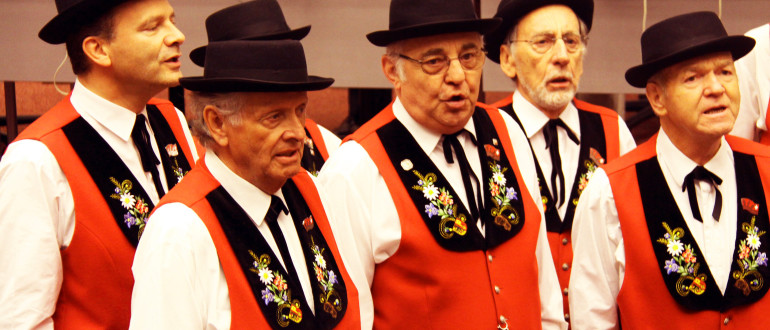Switzerland is another extremely important region of polyphonic traditions of Central Europe. With polyphonic choral singing based on European classical harmony and yodel, many regions of Switzerland (particularly of the Swiss-German areas) are close to the Austrian style of vocal polyphony.
The Swiss-German regions are perhaps the most polyphonic, with several regional styles of the yodel and traditions of vocal polyphony, and with a tradition of festivals of singers, organized from 1825 onwards. Perhaps the most archaic style of yodeling exists among several families of Muotatal (under the name juuz, juuzli). This three-part singing tradition is still based on European classical harmony, although the singing style is not refined and is based on glissandos and uncertain and sometimes non-tempered pitches during singing.
In Appenzell special yodeling competitions are traditionally held. Here the tradition of polyphonic singing also features yodeling (in a local style the yodel is lower in range), and is accompanied by two or three other parts – drones (gradhabe “to keep it straight”) (Hoffman & Delorenzi-Schenkel, 2000:691). Another yodeling style (schnelzer) in the same region (Appenzell) is known for its acceleration. Lucerne polyphonic singing also includes long drones with European harmonies and the use of yodel (Hoffman & Delorenzi-Schenkel, 2000:691). In still another region, Solothurn, “singing was formerly accompanied by clapping hands, slapping thighs, or drumming on a table. Other movements – holding the hand or little finger to the ear, pressing the throat to manipulate vocal quality, and other techniques – were commonly associated with singing in many areas. Tight closed circles, in which singers held their heads close together, commonly occurred” (Hoffman & Delorenzi-Schenkel, 2000:691).
The Italian-speaking area is also represented by the contemporary polyphonic singing style in parallel thirds. This polyphonic style is widely spread throughout the alpine region.
A big part of the folk repertoire of the Romansh-speaking area is religious songs. The information about their singing style (metallic high and loud voice) comes from the 18th century. Their singing style was described as “an ugly yelling and screaming” (Hoffman & Delorenzi-Schenkel, 2000:692). The tradition of two-, three- and four-part singing with European major-minor harmonies is still well alive in this region.
According to the available information, the French-speaking area is the most monophonic in Switzerland (not unlike France itself). Hoffman and Delorenzi-Schenkel mention only the tradition of group unison singing from this region.
To complete the review of the Central European region, we need to mention as well that two-part singing of the typical late European style has been recorded sporadically in Belgium and Holland (Bosmans, 2000:520)





